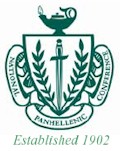National Panhellenic Conference
| National Panhellenic Conference | |
|---|---|

| |
| Data | |
| Established | 1902 |
| Members | 26 |
| Continent | North America |
| Country | United States and Canada |
| Organization type | Trade organization |
The National Panhellenic Conference (NPC), founded in 1902, is an umbrella organization for 26 (inter)national women's sororities.
Each member group is autonomous as a social, Greek-letter society of college women and alumnae. Members are represented on over 650 college and university campuses in the United States and Canada and in over 4,600 alumnae associations, making up over 4 million sorority women.[1]
The National Panhellenic Conference provides support and guidance for its 26-member international sororities/women's fraternities and serves as the national voice on contemporary issues of sorority life. Founded in 1902, NPC is one of the oldest and largest women's membership organizations representing more than 4 million women at 655 college/university campuses and 4,500 local alumnae chapters in the U.S. and Canada. Each year, NPC-affiliated collegians and alumnae donate more than $5 million to worthy causes, provide $2.8 million in scholarships to women and volunteer 500,000 hours in their communities.[2]
Members
| Sorority | Year Founded | Year Joined NPC |
|---|---|---|
| Alpha Chi Omega | 1885 | 1903 |
| Alpha Delta Pi | 1851 | 1909 |
| Alpha Epsilon Phi | 1909 | 1951 |
| Alpha Gamma Delta | 1904 | 1909 |
| Alpha Omicron Pi | 1897 | 1905 |
| Alpha Phi | 1872 | 1902 |
| Alpha Sigma Alpha | 1901 | 1951 |
| Alpha Sigma Tau | 1899 | 1951 |
| Alpha Xi Delta | 1893 | 1904 |
| Chi Omega | 1895 | 1903 |
| Delta Delta Delta | 1888 | 1902 |
| Delta Gamma | 1873 | 1902 |
| Delta Phi Epsilon | 1917 | 1951 |
| Delta Zeta | 1902 | 1910 |
| Gamma Phi Beta | 1874 | 1902 |
| Kappa Alpha Theta | 1870 | 1902 |
| Kappa Delta | 1897 | 1912 |
| Kappa Kappa Gamma | 1870 | 1902 |
| Phi Mu | 1852 | 1911 |
| Phi Sigma Sigma | 1913 | 1951 |
| Pi Beta Phi | 1867 | 1902 |
| Sigma Delta Tau | 1917 | 1951 |
| Sigma Kappa | 1874 | 1905 |
| Sigma Sigma Sigma | 1898 | 1951 |
| Theta Phi Alpha | 1912 | 1951 |
| Zeta Tau Alpha | 1898 | 1909 |
History
Early histories of women's fraternities contain accounts of "rushing and pledging agreements" or "compacts" among fraternities on various campuses, and also many stories of cooperation and mutual assistance. However, no actual Panhellenic organization existed and no uniform practices were observed.
By 1902, it was obvious that some standards were needed, so the women of Alpha Phi invited Pi Beta Phi, Kappa Alpha Theta, Kappa Kappa Gamma, Delta Gamma, Gamma Phi Beta, Delta Delta Delta, Alpha Chi Omega, and Chi Omega to a conference in Chicago on May 24. Alpha Chi Omega and Chi Omega were unable to attend. The remaining seven groups met and the session resulted in the organization of the first interfraternity association and the first intergroup organization on college campuses. National Interfraternity Conference for men's fraternities was organized in 1909, now called the North-American Interfraternity Conference.
This meeting, and the next few, resulted in several mutual agreements, especially regarding pledging. Up to this time, no guidelines had been set, and women could be pledged to groups before enrolling in college and, indeed, even belong to more than one group.
The fact that NPC is a "Conference" is significant to the NPC philosophy because the organization is a conference, not a congress. It enacts no legislation except for the conduct of its own meetings. Other than the basic Unanimous Agreements which all groups have voted to observe, NPC confines itself to recommendations and advice, and acts as a court of final appeal in any College Panhellenic difficulty. One of its greatest services is providing Area Advisors for College Panhellenics and Alumnae Panhellenics.
AES merger with NPC
Members of Sigma Sigma Sigma and Alpha Sigma Alpha organized the Association of Pedagogical Sororities on July 10, 1915. The membership consisted of sororities, who were primarily located on state campuses where women entering the educational field were predominant. In 1917, Pi Kappa Sigma and Delta Sigma Epsilon joined the association, followed by Theta Sigma Upsilon in 1925, Alpha Sigma Tau in 1926, and Pi Delta Theta in 1931. At the third biennial conference, the name of the association was changed to the Association of Educational Sororities (AES). Later, the word "Educational" was changed to "Education".
The AES was a strong group of leaders that focused not only on educational (providing scholarships) and women-centric issues, but cooperated to support issues outside of the sorority world including defense projects during World War II. One of the projects started by the AES member groups resulted in what is today the world-renowned Leader Dogs for the Blind School in Rochester, Michigan.
After much work on the part of NPC and AES, on November 12, 1947, the six AES sororities were unanimously accepted as associate members of NPC. At the same time, five other sororities were also admitted. In December 1951, the six AES sororities became full members of NPC.
Since that time, three have merged with other NPC member groups leaving Alpha Sigma Alpha, Alpha Sigma Tau, and Sigma Sigma Sigma as the remaining former-AES members.
Notes
References
- ^ "About NPC". NPC. 2009. Retrieved 2009-07-25.
- ^ "National Panhellenic Conference". National Panhellenic Conference. Retrieved 2010-01-01.
